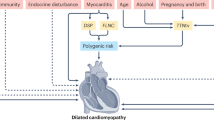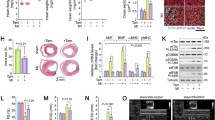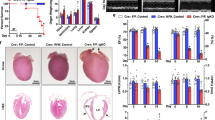Abstract
Background
Dilated cardiomyopathy (DCM) in children is often associated with poor morbidity and mortality and exhibits distinct pathological entities from those of adult DCM. Owing to the limited number of patients and the lack of a good animal model, the molecular mechanisms underlying pediatric DCM remain poorly understood. The purpose of this study is to establish an animal model of neonatal DCM and identify early progression factors.
Methods
Cardiac phenotypes and comprehensive gene expression profiles in homozygous ΔK210 knock-in (TNNT2ΔK210/ΔK210) mice were analyzed and compared to TNNT2+/ΔK210 and wild-type mice at 0 days and 1 week of age.
Results
Immediately after birth, the cardiac weight in TNNT2ΔK210/ΔK210 mice was already increased compared to that in TNNT2+/ΔK210 and wild-type mice. Echocardiographic examination of 0-day-old and 1-week-old TNNT2ΔK210/ΔK210 mice revealed similar phenotypes of pediatric DCM. In addition, several genes were significantly upregulated in the ventricular tissues of TNNT2ΔK210/ΔK210 mice, and the KEGG PATHWAY analysis revealed several important pathways such as cancer and focal adhesion that might be associated with the pathogenesis and development of DCM.
Conclusions
TNNT2ΔK210/ΔK210 mice have already developed DCM at birth, indicating that they should be an excellent animal model to identify early progression factors of DCM.
Impact
-
TNNT2ΔK210/ΔK210 mice are excellent animal model for DCM.
-
TNNT2ΔK210/ΔK210 mice are excellent animal model to identify early progression factors of DCM.
-
KEGG PATHWAY analysis revealed that several important pathways such as cancer and focal adhesion might be associated with the pathogenesis and development of neonatal DCM.
Similar content being viewed by others
Log in or create a free account to read this content
Gain free access to this article, as well as selected content from this journal and more on nature.com
or
References
Lipshultz, S. E. et al. The incidence of pediatric cardiomyopathy in two regions of the United States. N. Engl. J. Med. 348, 1647–1655 (2003).
Towbin, J. A. et al. Incidence, causes, and outcomes of dilated cardiomyopathy in children. JAMA 296, 1867–1876 (2006).
Daubeney, P. E. et al. Clinical features and outcomes of childhood dilated cardiomyopathy: results from a national population-based study. Circulation 114, 2671–2678 (2006).
Lee, T. M. et al. Pediatric cardiomyopathies. Circ. Res. 121, 855–873 (2017).
Patel, M. D. et al. Pediatric and adult dilated cardiomyopathy represent distinct pathological entities. JCI Insight 2, e94382 (2017).
Tatman, P. D. et al. Pediatric dilated cardiomyopathy hearts display a unique gene expression profile. JCI Insight 2, e94249 (2017).
Hanson, E. L. et al. Cardiac troponin T lysine 210 deletion in a family with dilated cardiomyopathy. J. Card. Fail. 8, 28–32 (2002).
Martins, E. et al. Familial dilated cardiomyopathy with troponin T K210del mutation. Rev. Port. Cardiol. 25, 295–300 (2006).
Mogensen, J. et al. Severe disease expression of cardiac troponin C and T mutations in patients with idiopathic dilated cardiomyopathy. J. Am. Coll. Cardiol. 44, 2033–2040 (2004).
Du, C. K. et al. Knock-in mouse model of dilated cardiomyopathy caused by troponin mutation. Circ. Res. 101, 185–194 (2007).
Kusakari, Y. et al. Impairment of excitation-contraction coupling in right ventricular hypertrophied muscle with fibrosis induced by pulmonary artery banding. PLoS ONE 12, e0169564 (2017).
Kanehisa, M. et al. From genomics to chemical genomics: new developments in KEGG. Nucleic Acids Res 34, D354–D357 (2006).
Chen, S. N. et al. DNA damage response/TP53 pathway is activated and contributes to the pathogenesis of dilated cardiomyopathy associated with LMNA (Lamin A/C) mutations. Circ. Res. 124, 856–873 (2019).
Hou, N. et al. Activation of Yap1/Taz signaling in ischemic heart disease and dilated cardiomyopathy. Exp. Mol. Pathol. 103, 267–275 (2017).
Xiao, J., Li, F., Yang, Q., Zeng, X. F. & Ke, Z. P. Co-expresssion analysis provides important module and pathways of human dilated cardiomyopathy. J. Cell. Physiol. 235, 494–503 (2020).
Huang, H. et al. Identification of potential gene interactions in heart failure caused by idiopathic dilated cardiomyopathy. Med. Sci. Monit. 24, 7697–7709 (2018).
Windak, R. et al. The AP-1 transcription factor c-Jun prevents stress-imposed maladaptive remodeling of the heart. PLoS ONE 8, e73294 (2013).
Levkau, B. et al. Survivin determines cardiac function by controlling total cardiomyocyte number. Circulation 117, 1583–1593 (2008).
Sheng, L. et al. Downregulation of Survivin contributes to cell-cycle arrest during postnatal cardiac development in a severe spinal muscular atrophy mouse model. Hum. Mol. Genet. 27, 486–498 (2018).
Santini, D. et al. Surviving acute myocardial infarction: survivin expression in viable cardiomyocytes after infarction. J. Clin. Pathol. 57, 1321–1324 (2004).
Abbate, A. et al. Myocardial expression of survivin, an apoptosis inhibitor, in aging and heart failure. An experimental study in the spontaneously hypertensive rat. Int. J. Cardiol. 111, 371–376 (2006).
Gil-Cayuela, C. et al. New altered non-fibrillar collagens in human dilated cardiomyopathy: role in the remodeling process. PLoS ONE 11, e0168130 (2016).
Wang, F. et al. Developmental changes in lysophospholipid receptor expression in rodent heart from near-term fetus to adult. Mol. Biol. Rep. 39, 9075–9084 (2012).
Pashmforoush, M. et al. Nkx2-5 pathways and congenital heart disease; loss of ventricular myocyte lineage specification leads to progressive cardiomyopathy and complete heart block. Cell 117, 373–386 (2004).
Voit, A. et al. Reducing sarcolipin expression mitigates Duchenne muscular dystrophy and associated cardiomyopathy in mice. Nat. Commun. 8, 1068 (2017).
Beard, N. A., Sakowska, M. M., Dulhunty, A. F. & Laver, D. R. Calsequestrin is an inhibitor of skeletal muscle ryanodine receptor calcium release channels. Biophys. J. 82, 310–320 (2002).
Wang, Q., Reiter, R. S., Huang, Q. Q., Jin, J. P. & Lin, J. J. Comparative studies on the expression patterns of three troponin T genes during mouse development. Anat. Rec. 263, 72–84 (2001).
Wei, B. & Jin, J. P. TNNT1, TNNT2, and TNNT3: isoform genes, regulation, and structure-function relationships. Gene 582, 1–13 (2016).
Pinto, J. R. et al. Fetal cardiac troponin isoforms rescue the increased Ca2+ sensitivity produced by a novel double deletion in cardiac troponin T linked to restrictive cardiomyopathy: a clinical, genetic, and functional approach. J. Biol. Chem. 286, 20901–20912 (2011).
Venkatraman, G., Gomes, A. V., Kerrick, W. G. & Potter, J. D. Characterization of troponin T dilated cardiomyopathy mutations in the fetal troponin isoform. J. Biol. Chem. 280, 17584–17592 (2005).
Acknowledgements
The authors acknowledge Ms. Naoko Tomizawa for her technical support of this research. This work was supported by grants from the Ministry of Education, Culture, Sports, Science and Technology of Japan (to J.T., S. Morimoto, S. Minamisawa), the Vehicle Racing Commemorative Foundation (S. Minamisawa), the Uehara Memorial Foundation (S. Minamisawa), the Descente and Ishimoto Memorial Foundation for Promotion of Sports Science (J.T.), The Jikei University Graduate Student Research Grant (Y.F., S.B.), and the Miyata Cardiology Research Promotion Foundation (S. Minamisawa).
Author information
Authors and Affiliations
Contributions
J.T., T.F., S.B., and Y.F. conceived and performed the experiments. J.T., S. Morimoto, and S. Minamisawa conducted and supervised the experiments. S. Morimoto and S. Minamisawa designed the experiments. J.T. and S. Minamisawa wrote the manuscript, and all authors discussed the results and commented on the manuscript.
Corresponding author
Ethics declarations
Competing interests
The authors declare no competing interests.
Additional information
Publisher’s note Springer Nature remains neutral with regard to jurisdictional claims in published maps and institutional affiliations.
Rights and permissions
About this article
Cite this article
Tanihata, J., Fujii, T., Baba, S. et al. Troponin T amino acid mutation (ΔK210) knock-in mice as a neonatal dilated cardiomyopathy model. Pediatr Res 89, 846–857 (2021). https://doi.org/10.1038/s41390-020-1016-1
Received:
Revised:
Accepted:
Published:
Issue date:
DOI: https://doi.org/10.1038/s41390-020-1016-1



